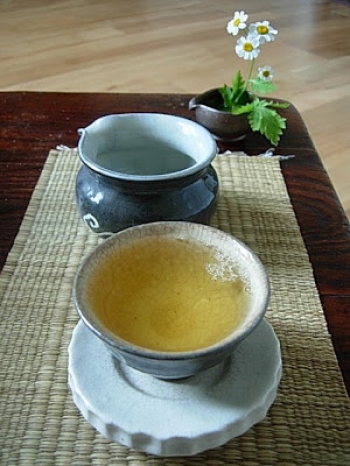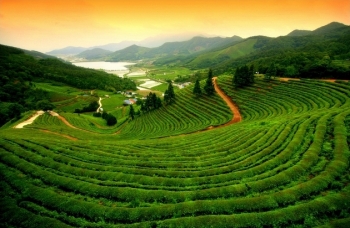When I was a nun at the Seon (Zen) temple Songgwangsa, I would often take a walk up the steep hill that led to Bulilam, the hermitage of Beopjeong Sunim (1932–2010). Venerable Beopjeong was a renowned writer who had retired to this small hermitage and developed a “non-possession” philosophy. He was also a tea specialist. One of the joys of visiting him was to be offered a cup of tea. He used to do this in a very traditional way. Once, he explained in detail the Korean way of tea:
“In preparing green tea, one should first bring the water to a boil. Then one should pour it into a largish bowl and let it cool to about 60 degrees Celsius. If the water is too hot, then too much of the tea’s bitterness will be extracted into the water. At this lower temperature, the fragrance of the tea is extracted more slowly. The teapot and cups should be warmed with some of the water. After placing the tea leaves in the teapot, pour in the water and let the leaves infuse for two or three minutes. It is important when pouring the tea to make sure that the taste is evenly distributed in all the cups. Therefore, never fill each cup in a single pouring, but fill them little by little—up to three servings each. While drinking the tea, refill the teapot with water. Do not gulp the tea but sip it slowly, allowing its fragrance to fill your mouth. There is no need to have any special attitude while drinking except one of thankfulness. The nature of the tea itself is that of ‘no mind.’ It does not discriminate and make differences—it is just as it is.
“There are four inherent attributes to tea: peacefulness, respectfulness, purity, and quietness. In drinking tea, these qualities should be cultivated in the drinker. Drinking tea gladdens the mind. The taste of the tea is the taste of the entire universe, because it is produced entirely through natural sunlight, water, wind, clouds, and air.”
Beopjeong Sunim was very knowledgeable about the history of the Korean way of tea:
“Tea is first mentioned in the ancient texts as an offering. In the Buddhist scriptures, it is often spoken of as an offering made to the Buddha. Originally, rice was not offered to the Buddha—just tea, incense, and flowers. Nowadays, although water is offered instead of tea, the Chinese character for tea is still used when describing the water employed in death ceremonies and harvest festivals.
“In the old days, as a sign of mutual respect, husband and wife would serve each other tea at their marriage. During the Silla dynasty [57 BCE–935 CE] tea was often used as a medicine. First, the leaves would be steamed and then pounded into the shape of a coin. This compressed form would be boiled for a long time in a medicine pot before being drunk. During the Koryo dynasty [935–1392] all people, commoners as well as aristocrats, drank tea. In this period, powdered tea was drunk in a large bowl. During the Yi period [1392–1910] the drinking of simple green-leaf tea was introduced. In this way one can observe a progression from complexity to simplicity in the preparation and the drinking of tea.”
At Songwangsa, one can find a hill surrounded by bamboo groves and glistening tea bushes. Beopjeong Sunim introduced us to the making of monastic green tea:
“In spring, we gather the tea leaves and then roast them by rolling them on a hot iron plate. This gives the tea in Korea a slightly burnt flavor. Such a flavor is very much liked by Koreans; it is also discernible in our rice-water and barley ‘tea.’ In Japan the people like the taste of seaweed, so often their tea has a similar taste to seaweed. The Chinese enjoy rich food. Thus they also tend to like their tea to have a strong flavor. In this way, you can see how the different tastes of people determine the flavor of their teas.
“The word for green tea in Korean is chaksol, which literally means ‘bird’s tongue.’ It is so called because the first leaves of the tea resemble the shape of a bird’s tongue. It is also called chugno, meaning ‘bamboo dew.’ It derives this name from the fact that tea plants often grow in bamboo groves and are nourished by the water which drips from the leaves of the bamboo.
“To determine whether the tea is a good one or not, one should examine its color, scent, and taste. The perfect color is like that of the first leaves in spring. The taste should resemble that of the skin of a young baby. The taste cannot be described, but can only appreciated through experience. Tea is drunk either to quench the thirst, to savor the taste, or simply to spend a quiet hour appreciating the pottery and the general atmosphere that accompanies tea-drinking.”
Beopjeong Sunim's hermitage was nestled amidst a bamboo forest on a steep hill. Climbing to visit him was a practice in itself. Arriving out of breath, the kind greeting and invitation to sit quietly and drink tea on the wooden veranda were a special treat. It is said that the taste of tea and the taste of Seon are the same, and at such times, I felt and experienced this strongly.
















